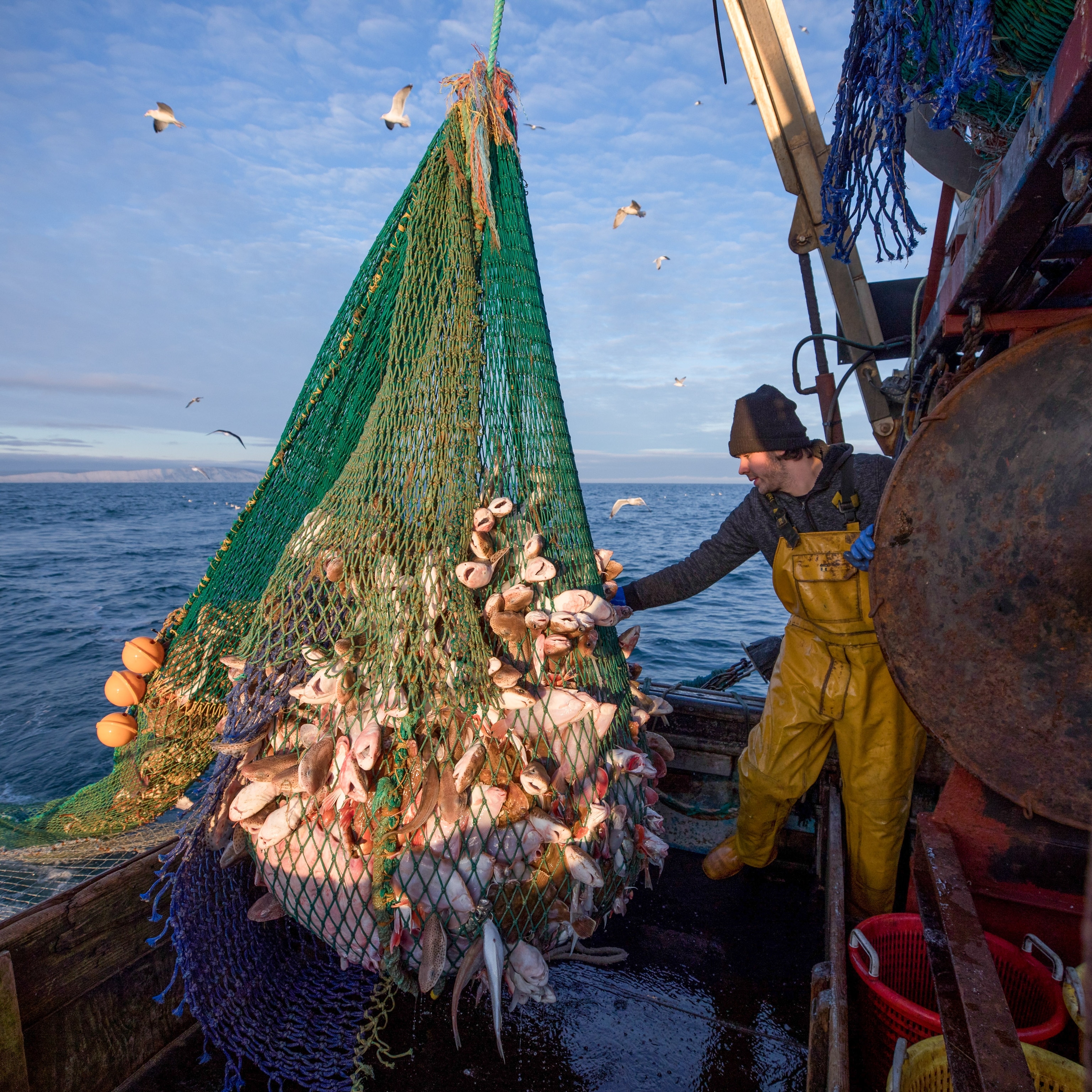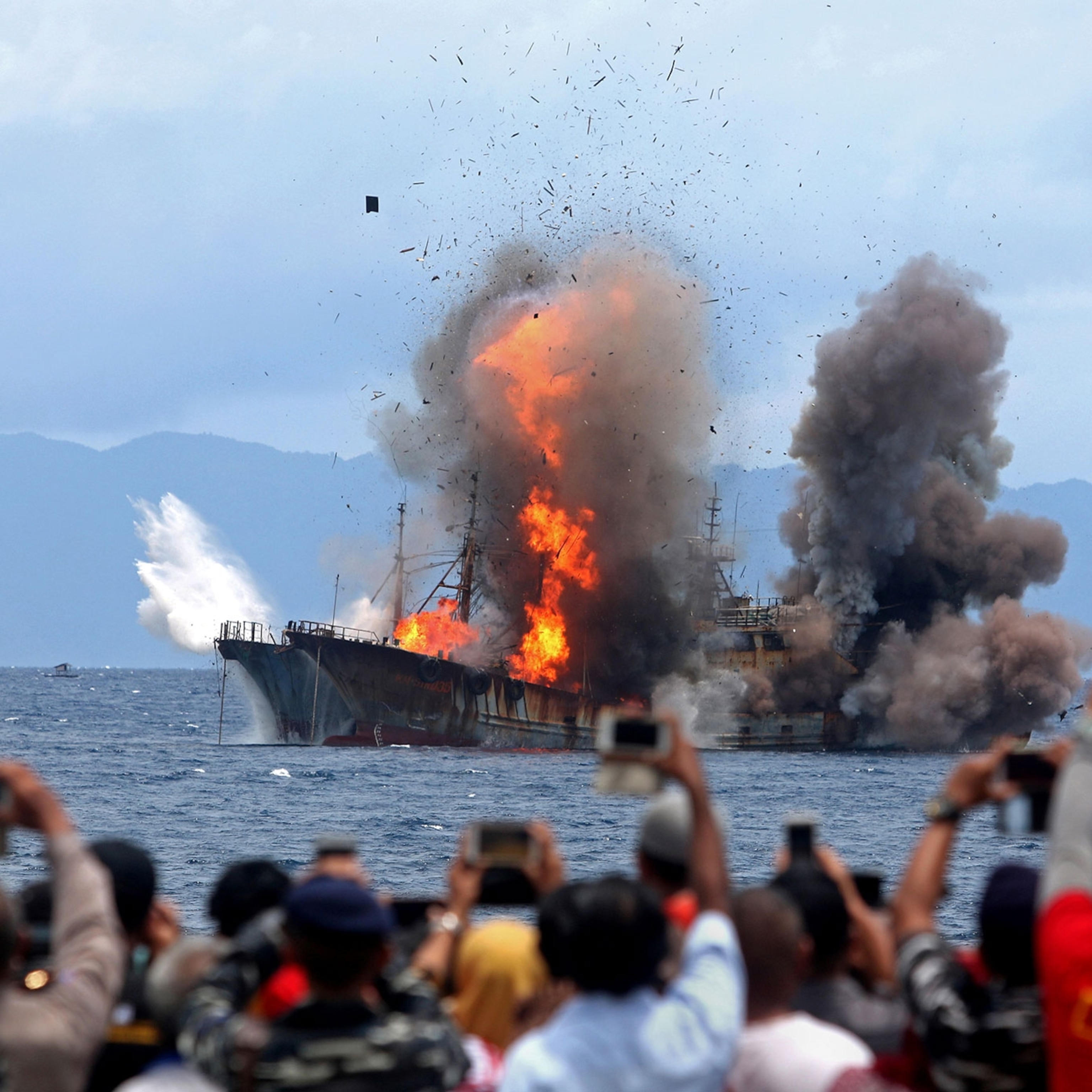Fish flee for their lives in rare, chilling video of bottom trawling
The never-before-seen footage of sea creatures struggling in fishing nets is featured in National Geographic’s new documentary Ocean with David Attenborough.

As a cloud of destruction approaches, all the creatures in its path scramble desperately to get out of the way—fleeing for their lives.
However fast they go, they can't outpace it. It looms closer and closer until it swallows them up.
Although it may sound like a disaster movie, this is a scene from newly released rare footage of bottom trawling—a particularly destructive method of fishing in which a ship drags a heavy iron net across the seabed, blindly catching anything in its path. These vessels usually fish for just one species—cod, haddock, and halibut, among other animals. Anything else is dumped overboard.
“It’s hard to imagine a more wasteful way to catch fish,” says David Attenborough in the new documentary Ocean with David Attenborough, which premieres on National Geographic on Saturday, June 7, at 9/8c and can be streamed globally the next day, World Oceans Day, on Disney+ and Hulu. “Over three quarters of a trawler’s catch may be thrown away.”
The filmmakers knew they wanted to shine a light on the harm caused by bottom trawling in the documentary—Attenborough’s statement piece on the health of our oceans. The number of animals killed unnecessarily by trawling was “the thing we found most distressing,” says Keith Scholey, the documentary’s co-director and executive producer at Silverback Films.
Yet they couldn’t find any clear footage of bottom trawling—so they had to find a way of filming it themselves. To capture the footage seen here, they got permission to mount cameras on the nets of a commercial trawler.
“We didn't really want to film it,” Scholey says, because that meant engaging with the destructive process. But the team decided that people need to see what really happens. They also filmed scallop dredging with scientists from the Marine Biological Association who were studying its impacts—and they agreed to make their footage of both trawling and dredging available to scientists “so that no one ever has to [film] it again,” Scholey says. “It's one of the most important things I've ever done in my career.”
The impact of bottom trawling
Enric Sala—a National Geographic Explorer and co-producer of Ocean with David Attenborough—has long studied the impacts of these fishing techniques. But even he was shocked by the footage, which shows not only the sea creatures’ desperate attempts to escape the trawler but close-up images of their wriggling bodies after they’re dumped onto the deck of the fishing vessel.
“I was outraged,” says Sala, who is also the founder of Pristine Seas, a National Geographic Society conservation program that has established 29 of the largest marine protected areas in the world. “I hope that people will understand the truth about industrial fishing.”
Some elements were too brutal to make the final cut. “There's some terrible shots of all these spider crabs being crunched up because the dredge has these teeth,” Scholey says of the scallop dredging scene.
It could have been even worse. When the videographers dropped cameras to check if an area was suitable to film dredging, they happened upon a piece of seafloor that trawlers avoid— perhaps because of the shape of the landscape.
They were gobsmacked to see a total contrast from the trawled areas nearby. The seafloor was covered with a carpet of pink sea fans. It can take these delicate corals a year to grow just one centimeter. If dredged, this habitat would take decades to recover.
Trawling “is like using a lawnmower to chop down everything in sight,” writes Max Valentine, a senior scientist and campaign director of illegal fishing and transparency at Oceana, in an email. (Valentine wasn't involved in the film.) “It also bulldozes the homes of other marine life.”
According to the film, trawling destroys an area of the ocean floor nearly as large as the Amazon rainforest every year—these vessels plough the seabed over and over, without giving it any chance to recover. Studies estimate that bottom trawling releases up to 370 million metric tons of carbon dioxide into the atmosphere every year, contributing to global warming.
Some deep-sea coral and sponges could take centuries to recover but many fish populations can bounce back in under five years when trawling stops.
Bottom trawling lands around 19 million tons of fish and invertebrates each year. That’s nearly a quarter of all wild marine fish caught. Scientists estimate the total weight of large predatory fish in the ocean today is just 10 percent of what it was before modern industrial fishing.
Surprisingly, however, bottom trawling and dredging is legal in most marine protected areas (MPAs).
Solutions for bottom trawling
One way to help the sea floor recover from trawling is to create marine protected areas where industrial fishing is banned. These can have a spillover effect as larvae born inside these protected areas drift on the current across the ocean—including into these devasted regions—boosting marine life populations there.
Many small-scale fishers support MPAs that are closed to fishing when they see the benefits this spillover has in boosting the numbers of their catch. “The worst enemy of fishing is overfishing, not protected areas,” Sala says. Conservationists and fishers both want the same thing: more fish in the sea.
Sala and other experts say we need to fully protect 30 percent of the world’s oceans from fishing for ecosystems to rebound and thrive. Currently, just 3 percent is fully protected. This would cost around $20 billion each year—around the same amount governments give as subsidies to the fishing industry.
Ocean with David Attenborough aims to highlight how policy can lead to remarkable ocean recovery—for example, Scholey says, when the International Whaling Commission banned commercial whaling in the 1980s.
“With a stroke of the pen, it ended,” he says, and some species bounced back from near extinction. “The recovery of whales in my lifetime is unbelievable.”
The filmmakers and other experts hope similar decisions will be made to protect the ocean from trawling at the upcoming United Nations Ocean Conference in June.
“It’s important for governments to step up and stop bottom trawling—and enforce bans that are already in place,” Valentine says.
“What we're doing to the ocean is horrible, but we can bring it back,” Sala says. “When we protect places, marine life comes back spectacularly. It turns deserts into beautiful jungles and forests and underwater forests.”








